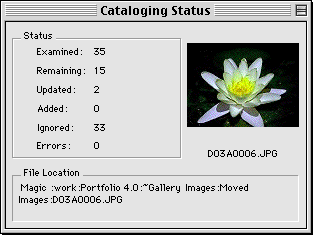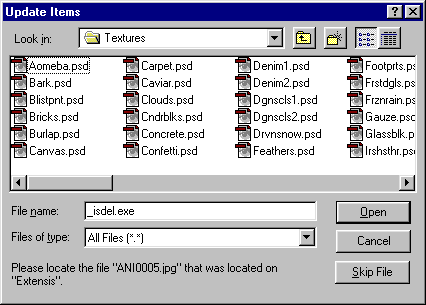When information associated with an item’s source file changes, you will want to “update” the catalog to reflect the changed information. You can update items individually, or update whole folders and volumes at the same time. You can even have Portfolio track changes and update automatically.
The process of updating changes the pointers to each item’s source file (if these have changed). Updating can also be used to regenerate item thumbnails (such as when the source file has been edited); to read in any new or modified information such as file modification date; and to update any keywords, descriptions, custom field data, etc. that is embedded in the file. You can control which types of fields are updated using the options in the Cataloging Options dialog that is displayed when you update items. You can also set default cataloging options (Catalog > Cataloging Options).
You will want to update cataloged items when you:
Move, rename, or delete files, folders, or volumes that have been cataloged.
Edit source file(s) and want the catalog records to reflect those changes.
Want to change the thumbnail size displayed in the catalog.
Tip: When you work with item source files from within Portfolio (such as moving, renaming, or deleting them), Portfolio is aware of source file changes. This allows Portfolio to update those records automatically, reducing or eliminating the amount of manual updating that you need to do. See Working with Item Source Files.
There are two ways to initiate an update:
Using the “Add Items...” command (or by dragging and dropping files into an open catalog). Using this method you provide Portfolio with the path to the source files (you tell Portfolio where to find them.) Portfolio will scan the files and update the information. For example: If you know which files, folders, or volumes contain source files that need to be updated and you have easy access to those files, or if you have a large number of items to update, you can drag and drop them into the catalog’s open Gallery window, or alternately select Catalog > Add Items, then locate the files or folders using the system folder hierarchy.
Using the “Update Items...” command. When you update using this method you are asking Portfolio to locate the source files. Portfolio will attempt to locate the files using the pathname in the catalog. If the files are found, the records will be updated. If the files are not found, you will be asked to locate them. For example: If you don’t know which links have changed, or you have just a few items to update and you don’t have easy access to the source files (such as when they are spread across a number of folders or volumes), you would select those items in the Gallery window, then choose Catalog > Update Items to initiate the update.
Tip: You can add and update items at the same time by dragging and dropping source file folders into an open catalog, then selecting “Add & Update” from the Cataloging Options dialog. If Portfolio finds a catalog item with the same name as any of the source files, the existing record is updated. If Portfolio doesn’t find a catalog item for a particular source file name, a new record is created.
After you initiate the update, Portfolio displays the Cataloging Options dialog so that you can select or change options before updating begins. Portfolio provides default Cataloging Options that will serve most needs, so you can quickly update without spending time learning about these options. (To select the default options, click “OK” on the Cataloging Options dialog.) You can bypass this dialog altogether by disabling this option in Portfolio’s Edit > Preferences dialog. With “Show Cataloging Options” disabled, Portfolio automatically applies the default cataloging options (or the last-saved options if any were specified in Catalog > Cataloging Options) each time you add or update catalog items.
To Update using the Drag and Drop/Add Items method:
Open the catalog that you want to update.
Locate the files, folders, or volumes to be updated, then drag and drop them into the open Gallery window.
— or —
Choose “Add Items...” from the Catalog menu, or press Command+E (Mac OS) or Ctrl+E (Windows), then locate the files, folders, or volumes that you want to have updated.
Refer to the Add chart for instructions on specifying folders, sub-folders and volumes.
The Cataloging Options dialog will be displayed, allowing you to choose a variety of options for updating the files.
From the Cataloging Options dialog, select “Update,” “Add & Update,” or “Update Unconditionally” from the Modify Method option of the General tab.
You can review or change the other options, or simply allow Portfolio to use the default options presented. Click “OK.”
Portfolio scans the volume(s) containing the source files and updates item records based on the Cataloging Options settings.

To Update using the Update Items method:
Open the catalog that you want to update.
In the Gallery window, select the items that you want updated. To update all the items, choose Edit > Select All [Command+A (Mac OS) Ctrl+A (Windows)].
Choose Catalog > Update Items... [Command+U (Mac OS) Ctrl+U (Windows)].
Review or change Cataloging Options (to change Modification method see sidebar Tip), or simply allow Portfolio to use the options presented, then click “OK.”
Portfolio searches for each item’s source file using the pathname stored in the item record.
Tip: The Update Items command (Catalog > Update Items...) automatically defaults to the “Update” Modification Method. You can set it to “Update Unconditionally” from the Cataloging Options dialog.
If the source file is found, the record is updated based on the Cataloging Options settings.

If the source file cannot be found, you are prompted to locate it. If you select a new file for the selected item, the record is updated with information from the new file, based on the Cataloging Options settings.
Tip: Portfolio automatically updates all selected items located in the same folder (after you locate the first file, others in the same folder will be updated automatically).
If the source file cannot be found and you click “Skip File” when prompted to locate the file, the selected record is left untouched.
You can elect to regenerate thumbnails when you update catalog items by choosing this option in the Cataloging Options dialog (Catalog > Cataloging Options: Rules tab). Regenerating during an update offers the same options: by extracting the thumbnail from the source file or by building a thumbnail.
You may want to regenerate the thumbnail for an item when you have edited the file and the thumbnail has changed. In this case, choose Regenerate Thumbnails from the Rules tab, then choose “Update Items.” The Cataloging Options dialog opens with the default update method “Update” selected. Update checks the modification date; since this has changed, the item will be updated.
Tip: You can edit and update your images and media files right from the catalog—without ever having to search for the source files: Use the Edit Original command (Item > Edit Original) to open the item for editing. Modify and save the file as usual, then return to Portfolio and choose “Update Items.” Because the source file has not moved, Portfolio will update the record without asking you to locate it.
You might also want to regenerate thumbnails in order to switch between using a 112 x 112 pixel thumbnails and the larger 256 x 256 pixel thumbnails. In this case, choose Regenerate Thumbnails from the Rules tab, then select “Update Items.” This will open the Cataloging Options dialog where you can switch the update type to Update Unconditionally; Update Unconditionally does not check to see if modification date has changed. A standard Update would check for a modification date change and skip the update because the source file has not been modified.
Note: When you change Modify Method setting during an update, it only changes the modification method for that session. That is, if “Add” was set as the Modify Method previously, it will still be set to “Add” after the “Update Items” command is executed.
Tip: You can manually update an item’s thumbnail by previewing the item, then choosing Item > Regenerate Thumbnail.